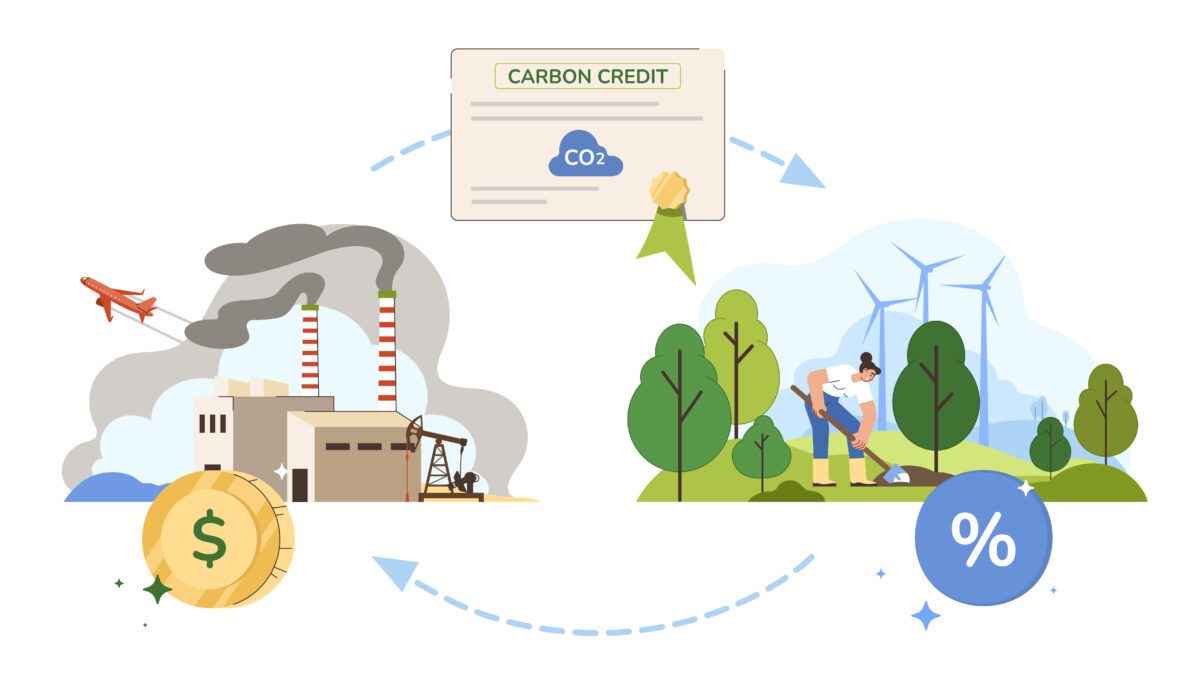Understanding Carbon Credits and How They Can Be Harnessed In The African Agriculture

Global warming, fueled by the greenhouse gas effect, poses a significant threat to our planet. Agriculture, contributing to about one-third of global GHG emissions, is both a culprit and a potential savior in this scenario.
Climate change is a consequence of the greenhouse gas (GHG) effect, resulting from the release of GHGs like carbon dioxide (CO2), methane (CH4), and nitrous oxide (N2O). These gases trap sunlight within the atmosphere, causing an increase in temperature. The greater the concentration of GHGs in the atmosphere, the more elevated the temperature becomes. Primary sources of GHG emissions stem from various human activities, including electricity and heat production, transportation, agriculture, and alterations in land use. It is estimated that agri-food systems contribute approximately one-third of the total global GHG emissions.
Addressing climate change is especially crucial for countries with lower-middle and low incomes, where agriculture contributes a larger proportion to overall greenhouse gas (GHG) emissions compared to wealthier nations. A study published in 2020 shows that in low-income countries, agriculture is responsible for 48% of total emissions, whereas in high-income countries, it constitutes 7%. Additionally, research study published in 2023 in the American Association Journal has shown that implementing measures to reduce GHG emissions can be economically viable in middle- and low-income countries. Despite agriculture being a significant source of GHG emissions, it also holds a critical role in mitigating the impacts of climate change.
Understanding Carbon Credits and their Global Impact
To reverse the effects of climate change, the spotlight has now shifted to carbon credits, a mechanism designed to reward those who actively reduce emissions or sequester carbon. This concept forms the backbone of carbon markets, which are either compliance markets regulated by governments or voluntary carbon markets (VCM), where participation is voluntary.
This revolutionary concept has taken center stage in agriculture, promising not only to combat climate change but also to reinforce the financial standing of farmers.
In the intricate web of climate change mitigation, agriculture emerges as a player rather than just a contributor. Farmers, who often bear the brunt of climate change impacts, can now be at the forefront of positive change. By adopting sustainable practices, they can generate carbon credits, a quantifiable unit representing a reduction of one metric ton of carbon dioxide equivalent (CO2e). This reduction is achieved by implementing eco-friendly practices, such as avoiding the traditional burning of agricultural residues.
In the heart of this transformative movement lies Africa, where the potential for farmers to enter the carbon credit market is a game-changer. The unique socio-economic landscape of the continent, combined with the growing awareness of climate issues, positions African farmers as key players in this global sustainability movement.
READ: The Controversy and Potential of CDR Technologies
The Process of Carbon Credit Generation
Reducing greenhouse gas (GHG) emissions involves implementing policies that fall into two main categories: regulations and incentives. Carbon markets, which put a price tag on carbon emissions, are built on these foundations, and there are two types: compliance markets, regulated by governments or international agencies, and voluntary carbon markets (VCM), which offer incentives for emission reduction. Unlike compliance markets, participation in VCM is voluntary, where individuals, companies, or governments trade carbon credits generated from activities like agriculture.
The journey begins with project developers conceptualizing and designing projects tailored to specific carbon offset programs. In Africa, startups and established companies alike are spearheading initiatives, assisting farmers in implementing sustainable agricultural practices. The resulting emissions reduction is validated and verified by third-party bodies, ensuring the credibility of the process.
Recognizing the potential of carbon markets, some governments across the globe are gearing up to launch their own carbon market. The core of these markets lies in carbon credits, where entities can earn financial rewards for reducing emissions below a specified baseline. The reduction is measured in carbon credits, each equivalent to one metric ton of carbon dioxide equivalent (CO2e), a unit considering the warming potential of CO2, CH4, and N2O.
Consider a scenario where a carbon company or an NGO persuades farmers not to burn crop residue. They propose a plan that if the farmers abstain from burning, they will receive a specified amount of money after verification. The farmer agrees, refrains from burning, and achieves a reduction of 1.5 tonnes of CO2e per hectare compared to the previous season. This reduction translates to the generation of 1.5 carbon credits per hectare, with each credit valued at US$10 in the market. According to the agreement, 60% of the revenue reaches the farmers, resulting in an estimated amount of approximately 1,400 Kenya Shillings per hectare.
Importantly, the disbursal of funds is contingent on a third-party verifier confirming that the farmer has indeed refrained from burning residues, and that the calculations are accurate. This approach not only provides financial incentives for farmers to adopt sustainable practices but also contributes to climate change mitigation. The involvement of a third-party verifier ensures the process’s integrity and credibility, providing assurance to all stakeholders.
Consumer Packaged Goods (CPG) Companies as Catalysts
A global shift driven by changing consumer preferences and Environmental and Social Governance (ESG) has placed Consumer Packaged Goods (CPG) companies at the forefront of the carbon credit market. As these companies strive to meet their environmental commitments, they increasingly rely on purchasing carbon credits from farmers, creating a new revenue stream for agricultural communities.
The narrative extends beyond Africa, echoing similar tales from across the globe. Agriculture is evolving into a sector where sustainability is not just an option but a necessity. The collaboration between farmers, CPG companies, and global sustainability initiatives showcases the transformative power of agriculture. Each farmer becomes a key stakeholder in the battle against climate change, simultaneously contributing to a more sustainable and prosperous tomorrow.



